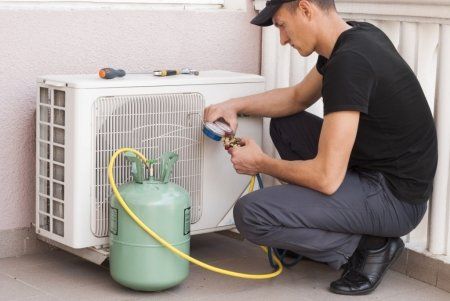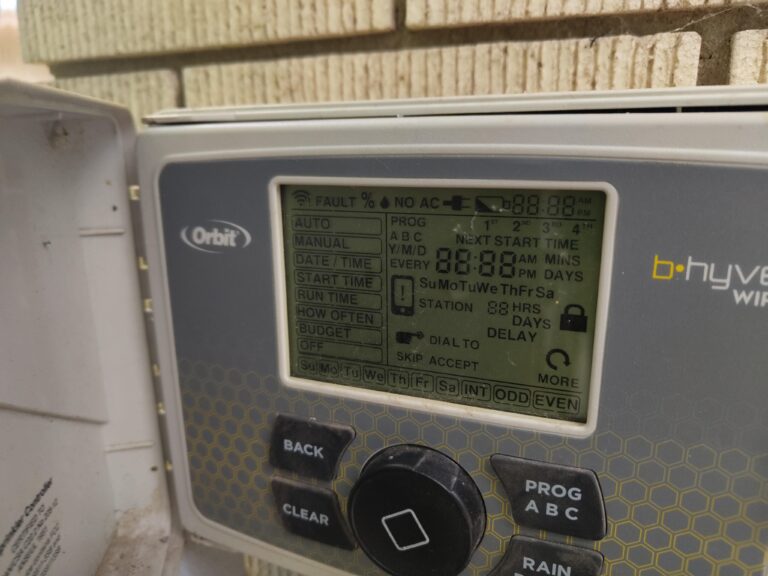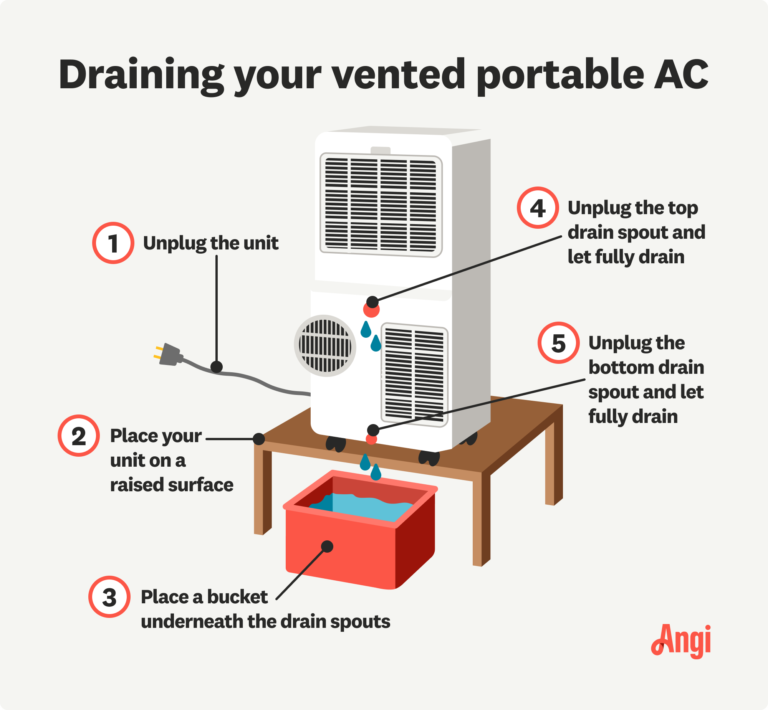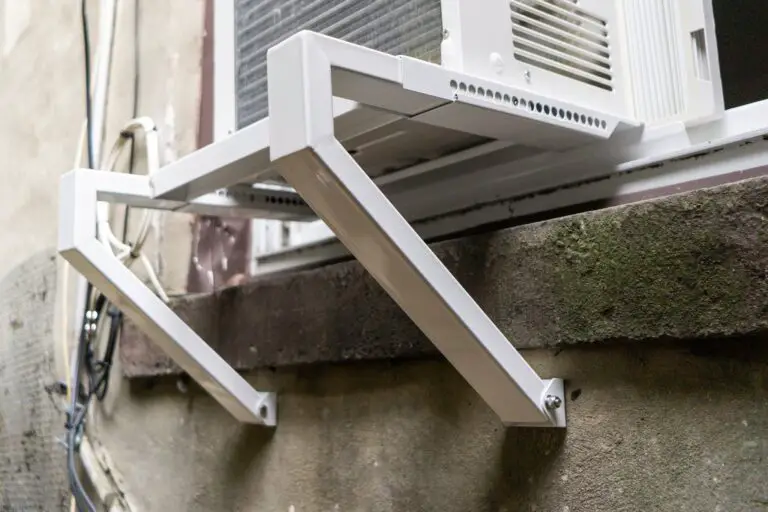Where Do You Put Freon In An Air Conditioner: Ultimate Guide
You put Freon in the air conditioner’s low-pressure service port. This port is typically located near the compressor.
Adding Freon to your air conditioner is essential for efficient cooling. Properly recharging your AC ensures it functions optimally during hot weather. Before starting, it’s crucial to identify the low-pressure service port. This port is usually near the compressor and marked with an “L” or “LOW”.
Always use the correct type of Freon specified by the manufacturer. Using the wrong type can damage the system. Be sure to wear safety gear, including gloves and goggles. Overcharging or undercharging the system can lead to inefficiencies or damage. Regular maintenance, including checking Freon levels, keeps your AC in top shape.
Introduction To Freon
Understanding Freon is key to maintaining your air conditioner. Freon is a crucial component in the cooling process. It ensures your home stays cool in summer.
What Is Freon?
Freon is a brand name for a group of chemicals. These chemicals are called chlorofluorocarbons (CFCs). Freon is used as a refrigerant in air conditioners. It absorbs heat from the indoor air, helping to cool it down.
Freon is a non-flammable gas. It is also non-toxic, making it safe for home use. Its chemical properties allow it to change from gas to liquid easily. This makes it perfect for cooling purposes.
Importance In Air Conditioners
Freon is essential for the cooling cycle in air conditioners. It absorbs heat from the room and releases it outside. Without Freon, your air conditioner would not work properly.
Freon keeps the air in your home comfortable. It helps maintain a steady, cool temperature. This ensures you stay comfortable during hot days.
Regularly checking Freon levels is important. Low Freon can lead to inefficient cooling. It can also cause your air conditioner to break down.
Here is a table showing the importance of Freon in air conditioners:
| Function | Explanation |
|---|---|
| Heat Absorption | Freon absorbs heat from inside the house. |
| Cooling | Freon cools the air by releasing absorbed heat outside. |
| Efficiency | Proper Freon levels ensure efficient air conditioner operation. |
Maintaining Freon levels can save you money. It reduces the need for repairs and lowers energy bills. Always ensure your air conditioner has the right amount of Freon.

Credit: www.instructables.com
Safety Precautions
Working with Freon in an air conditioner requires careful attention. Safety is the top priority to avoid harm. Follow these safety precautions to ensure a safe experience.
Personal Protective Equipment
Always wear Personal Protective Equipment (PPE) when handling Freon. This includes:
- Gloves: Protect your hands from chemical burns.
- Safety goggles: Shield your eyes from splashes.
- Long sleeves: Cover your skin to prevent exposure.
Ensure your PPE is in good condition. Replace any damaged items immediately.
Safe Handling Procedures
Follow these safe handling procedures to minimize risks:
- Work in a well-ventilated area to avoid inhaling fumes.
- Keep fire extinguishers nearby in case of emergency.
- Use only recommended tools and equipment.
- Ensure the air conditioner is off before starting.
- Identify the correct port for adding Freon.
Dispose of any waste materials properly. Do not release Freon into the air.
Tools Needed
Knowing the right tools to use is crucial for adding Freon to your air conditioner. Using the proper tools ensures a safe and effective process. Below, we’ll discuss the essential tools and optional accessories required for this task.
Essential Tools
- Manifold Gauge Set: This set measures the pressure of the refrigerant.
- Refrigerant: The Freon itself is a must-have.
- Refrigerant Scale: This scale ensures you add the correct amount of Freon.
- Protective Gloves: Protect your hands from harmful chemicals.
- Safety Glasses: Protect your eyes from refrigerant splashes.
Optional Accessories
- Leak Detector: Helps find leaks in the system.
- Thermometer: Checks the temperature of the air conditioner.
- Vacuum Pump: Removes any air and moisture from the system.

Credit: www.mitchwrightair.com
Locating The Low-pressure Port
Locating the low-pressure port is crucial for adding Freon to your air conditioner. This port is where you connect the Freon canister for recharging. Knowing how to find it helps ensure a smooth and safe process.
Identifying The Port
The low-pressure port is a key component of your air conditioning system. It’s usually marked with an “L” or “LOW”. Ensure the unit is off before you start. This will help you locate the port safely.
You may need to remove a cover or panel. This often involves using a screwdriver. The port is often metal and has a cap that screws on and off. It may have a valve inside that prevents leaks.
Common Locations
The low-pressure port is typically found on the larger of the two refrigerant lines. This line is usually cold to the touch. It may also have insulation around it. Here are some common places to check:
- Near the Compressor: This is the heart of your AC system. The port is often close to the compressor unit.
- Along the Refrigerant Lines: Follow the larger line from the compressor. The port is usually somewhere along this line.
- Close to the Evaporator Coil: This coil is often inside your home. The port may be near this component.
Using these tips, you can locate the low-pressure port with ease. This step is essential for adding Freon correctly.
Connecting The Freon Canister
Connecting the Freon canister to your air conditioner is crucial. It ensures your system runs smoothly. This process must be done with care to avoid issues. Below are steps for proper attachment and avoiding leaks.
Proper Attachment
First, turn off the air conditioner. This is a safety measure. Next, locate the service valve. It’s usually near the compressor. Attach the hose from the Freon canister to this valve. Ensure it’s snug but not overly tight.
Follow these steps:
- Turn off the air conditioner.
- Locate the service valve.
- Attach the hose from the Freon canister.
- Ensure the connection is snug.
Check the canister’s gauge. It should show the correct pressure. Open the valve on the canister slowly. Let the Freon flow into the system.
Avoiding Leaks
Leaks can cause your air conditioner to malfunction. To avoid them, double-check connections. Tighten any loose fittings. Use a leak detector for extra safety.
Steps to avoid leaks:
- Double-check all connections.
- Tighten any loose fittings.
- Use a leak detector.
Monitor the system for any signs of a leak. If you see bubbles, there’s a leak. Fix it immediately to prevent issues.
Regular maintenance can help avoid leaks. Keep your air conditioner in good condition. This ensures it runs efficiently.

Credit: www.youtube.com
Filling The System
Knowing where to put Freon in an air conditioner is crucial. The process ensures your AC runs smoothly. Here, we will guide you through each step. We will also cover monitoring pressure levels to avoid issues. Let’s dive into the step-by-step process.
Step-by-step Process
- Turn off the AC unit: Ensure the air conditioner is off. This is for safety.
- Locate the service port: Find the low-pressure service port. It is usually on the larger AC line.
- Attach the gauges: Connect the gauge set to the service port. Ensure a snug fit.
- Connect the Freon can: Attach the Freon can to the middle hose of the gauge set.
- Open the valve: Open the low-pressure valve to allow Freon in.
- Monitor the gauge: Keep an eye on the gauge to prevent overfilling.
- Close the valve: Once the correct amount is added, close the valve.
- Remove the gauges: Carefully detach the gauge set from the service port.
- Turn on the AC unit: Power on the air conditioner and check its performance.
Monitoring Pressure Levels
Keeping an eye on pressure levels is crucial. It ensures the AC operates efficiently. Use a gauge to measure pressure accurately.
| Pressure Range (psi) | Condition |
|---|---|
| 25-40 | Low Pressure |
| 40-55 | Optimal Pressure |
| 55-70 | High Pressure |
Keep the pressure within the optimal range. This prevents damage and ensures efficiency.
Checking For Leaks
Before adding Freon to your air conditioner, check for leaks. Leaks can waste refrigerant and harm the environment. Follow these steps to ensure your system is leak-free.
Inspection Techniques
Start with a visual inspection. Look for oil stains on the refrigerant lines. These stains indicate a possible leak. Check the connections and fittings. Make sure they are tight.
Next, use a soap solution. Mix water and soap in a spray bottle. Spray it on the refrigerant lines. Bubbles will form where there is a leak. This method is simple and effective.
Using Leak Detectors
Electronic leak detectors are more accurate. They detect even small leaks. Turn on the detector and move it along the refrigerant lines. The detector will beep or light up near a leak.
Ultraviolet (UV) dye is another option. Add the dye to the system. Use a UV light to find leaks. The dye will glow under the light. This method is useful for finding hidden leaks.
| Method | Tools Needed | Accuracy |
|---|---|---|
| Visual Inspection | Eyes, flashlight | Low |
| Soap Solution | Soap, water, spray bottle | Medium |
| Electronic Detector | Leak detector | High |
| UV Dye | UV dye, UV light | Very High |
Using these techniques will help you find any leaks. Fixing leaks ensures your air conditioner runs efficiently. It also protects the environment by preventing refrigerant loss.
Final Steps
You’ve successfully added Freon to your air conditioner. Now, it’s time to finish up. This section covers the final steps, ensuring everything runs smoothly.
Disconnecting Safely
Always disconnect safely to avoid accidents. First, turn off the air conditioner. This prevents any electrical hazards.
Next, remove the service port cap. Be cautious as Freon can be under pressure. Use a wrench if needed to loosen it.
Store the Freon canister properly. Keep it in a cool, dry place. Ensure it’s out of children’s reach.
Finally, dispose of any used materials responsibly. Check local guidelines for Freon disposal.
Testing The Air Conditioner
After disconnecting, it’s time to test the air conditioner. Turn it back on and set it to cool.
Wait for a few minutes. This allows the system to stabilize.
Check the air temperature. Use a thermometer for accuracy. The air should feel cold and refreshing.
If the air isn’t cold, there might be a leak. Inspect the connections and seals. Tighten any loose parts.
Finally, listen for unusual noises. Strange sounds can indicate issues. If you hear anything odd, consult a professional.
By following these final steps, you ensure your air conditioner works efficiently. Enjoy the cool, comfortable air!
Frequently Asked Questions
How Much Does It Cost To Refill Freon In Ac Unit?
Refilling Freon in an AC unit typically costs between $100 to $350. Prices vary based on the unit’s size and type.
How Do I Know When My Ac Needs Freon?
Your AC needs Freon if it blows warm air, takes longer to cool, or shows ice on the coils.
Can I Buy Freon For My Home Ac?
No, you cannot buy Freon for your home AC. Only certified technicians can purchase and handle Freon.
Conclusion
Understanding where to put Freon in your air conditioner is crucial. Always follow the manufacturer’s guidelines for safety. Regular maintenance ensures your AC runs efficiently. If unsure, consult a professional to handle Freon. This keeps your air conditioner in top shape and extends its lifespan.
Proper Freon management is key to staying cool.







